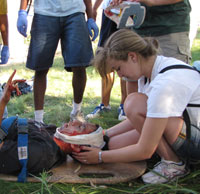
The SOAP note format provides a more detailed and advanced structure for decision making and problem solving in injury management. It is much more inclusive of the entire injury management process. Like the HOPS format, this evaluation method can be efficiently practiced by individuals who have acquired at least a first aid recertification.
There are two important components in the SOAP Note Format and the first one is the assessment. Following the objective evaluation, the examiner analyzes and assesses the individual’s status and prognosis. Although a definitive diagnosis may not be known, the suspected site of injury, involved structures, and severity of injury are documented. Subsequently, both long-term and short-term goals are established. Long-term goals should reflect the anticipated status of the individual after a period of rehabilitation and might include pain-free ROM; bilateral strength, power, and muscular endurance; cardiovascular endurance; and return to full functional status. Short-term goals are developed to outline the expected progress within days of the initial injury and might include immediate protection of the injured area and control of inflammation, hemorrhage, muscle spasm, or pain. Short-term goals are updated with each progress note. Progress notes may be written daily, weekly, or biweekly to document progress.
The second component is the Planning. The final section of the note lists the therapeutic modalities and exercises, educational consultations, and functional activities used to achieve the documented goals. The action plan should include the following information: the immediate treatment given to the injured individual; the frequency and duration of treatments, therapeutic modalities, and exercises; evaluation standards to determine progress toward the goals; ongoing patient education; and criteria for discharge.
As the short-term goals are achieved and updated, periodic “in-house review” of the individual’s records permits health care providers to evaluate joint ROM; flexibility; muscular strength, power, and endurance; balance or proprioception; and functional status. In addition, these reviews allow health care providers to discuss the continuity of documentation, efficacy of treatment, average time to discharge, and other parameters that may reflect quality of care. When it is determined that the individual can be discharged and cleared for participation, a discharge note should be written to close the file. All information included within the file is confidential and cannot be released to anyone without written approval from the patient. This is also the reason why you need to attend on an emergency first aid training course to be aware of this format.
Watch this related video about SOAP Note Tips For BHCs From Dr. Serrano
[media url=”http://www.youtube.com/watch?v=e8QHqSxaYdo” width=”600″ height=”400″]In a clinical setting, SOAP notes are the sole means of documenting the services provided to the patient. All clinicians have an ethical responsibility to keep accurate and factual records. This information verifies specific services rendered and evaluates the progress of the patient as well as the efficacy of the treatment plan. Insurance companies use this information to determine if services are being appropriately rendered and qualify for reimbursement. More important, this comprehensive record-keeping system can minimize the ever-present threat of malpractice and litigation. In general, the primary error in writing SOAP notes is the error of omission, whereby clinicians fail to adequately document the nature and extent of care provided to the patient. Formal documentation and regular review of records can reduce this threat and minimize the likelihood that inappropriate or inadequate care is being rendered to a patient.
[note color=”#d14549″]Emergency First Aid Training References:[/note]
Documenting general observations. Nursing 2006; 36(2):25.
http://downloads.lww.com/wolterskluwer_vitalstream_com/sample-content/9780781784450_Anderson/samples/98853.Ch5.pdf